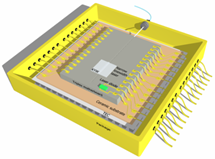- Jinfeng Mu - PhD student
- Sonia García Blanco - Scientific Staff
Potassium double tungstates are materials largely utlized in the realization of bulk solid state lasers that present high performance characteristics such as high output power, high efficiency and very narrow linewidth. In recent years, work at the University of Twente has demonstrated the utilization of this material to produce very efficient (>80% 1) waveguide lasers exhibiting high output power (> 1W 1) in rare-earth doped potassium double tungstates. The tunability of these devices was also demonstrated by the use of an external grating . Very narrow linewidth lasers (1.7 kHz) have been demonstrated using erbium ions doped into another host material, Al2O3 3. The wavelength of operation of these devices is determined by the rare-earth ion doped into the crystal matrix. Ytterbium (Yb3+) and Thulium (Tm3+) have been studied in recent years for laser operation wavelengths around 1 and 2 μm respectively. Er3+:KY(WO4)2 is currently being studied for on-chip amplification in the C-band.
Despite the excellent characteristics of these waveguide devices, its utilization is limited by the lack of integration with other passive components on the same chip. This is due to the fact that the host material, being crystalline, needs to be grown on a lattice matched substrate. Recent years have seen the development of heterogeneous integration technologies by which different materials are bonded together at the wafer level followed by further processing steps to define the active devices. Preliminary developments at the University of Twente have shown that thin layers of potassium double tungstates can be transferred onto silica-on-silicon substrates4. These thin layers are the base for the fabrication of laser devices proposed here.
The objective of this project is to develop on-chip narrow-linewidth (kHz range), tunable (across C-band), high power (tens of mW) lasers on Er3+:KY(WO4)2 integrated onto a passive photonic platform (TripleX) working in the C-band. The performance of the lasers proposed in this project is expected to overpass the performance of its semiconductor counterparts thanks to the gain and refractive index stability characteristics of rare-earth ions doped in this host material. Furthermore, the close proximity between the active and passive structures should lead to highly efficient devices.

Figure: Schematic representation of the module to be developed in this project. Erbium doped KY(WO4)2 will be integrated onto a passive TripleX motherboard in which the required interfaces to the active material as well as the passive circuitry to realize the wavelength stabilization, wavelength selection and delivery of the pump power will be implemented.
Articles
The following articles have been published regarding this project:
2016
Sefünç, M., Alexoudi, T., Mu, J., Dijkstra, M., & García Blanco, S. M. (2016). Fabrication of high-contrast waveguide amplifiers in erbium doped potassium double tungstates. Paper presented at 18th International Conference on Transparent Optical Networks, ICTON 2016, Trento, Italy.DOI: 10.1109/ICTON.2016.7550527
2014
Mu, J., Sefünç, M., & García Blanco, S. M. (2014). Design and length optimization of an adiabatic coupler for on-chip vertical integration of rare-earth-doped double tungstate waveguide amplifiers. In 16th International Conference on Transparent Optical Networks (ICTON), 2014 (pp. 1-4). Graz, Austria: IEEE. DOI: 10.1109/ICTON.2014.6876570
